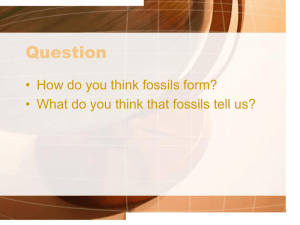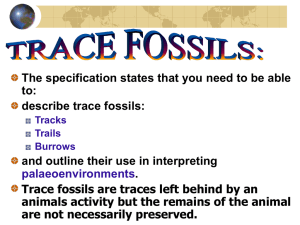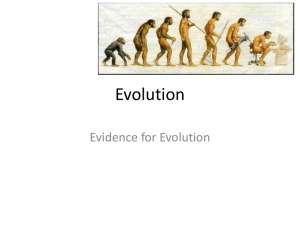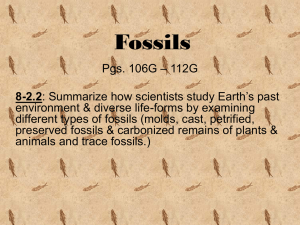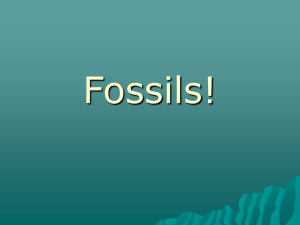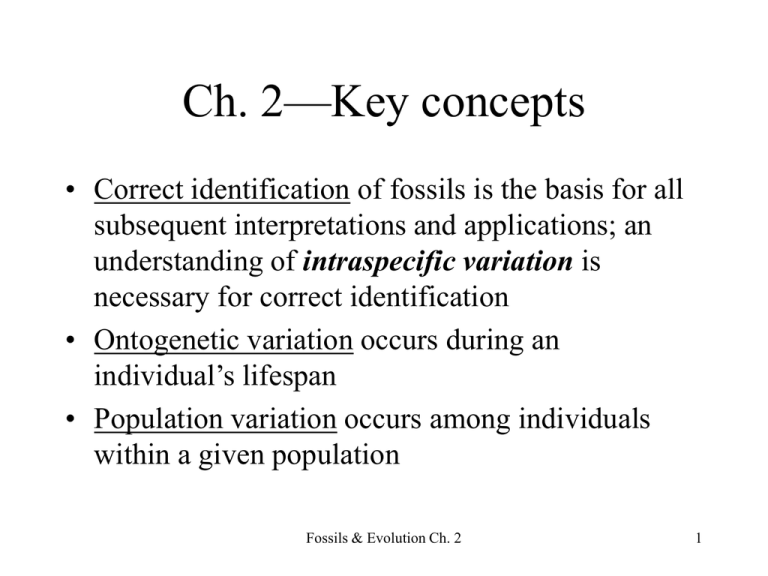
Ch. 2—Key concepts
• Correct identification of fossils is the basis for all
subsequent interpretations and applications; an
understanding of intraspecific variation is
necessary for correct identification
• Ontogenetic variation occurs during an
individual’s lifespan
• Population variation occurs among individuals
within a given population
Fossils & Evolution Ch. 2
1
Ch. 2—Key terms
• Ontogeny; ontogenetic variation
• Population variation
• Types of skeletal growth
– Addition; accretion; molting;
modification; combination
• Isometric vs. allometric growth
• Principle of similitude
• Ecophenotypic variation
• Sexual dimorphism
Fossils & Evolution Ch. 2
2
Ontogenetic variation
• Ontogeny = the life history of an individual
(both embryonic and post-natal)
• Understanding ontogeny is important
because growth stages of an individual may
be so different that they are hardly
recognizable as the same species
Fossils & Evolution Ch. 2
3
Types of skeletal growth
1.
2.
3.
4.
5.
Accretion (enlargement) of existing parts
Addition of new parts
Molting
Modification
Combinations (mixed growth strategies)
Fossils & Evolution Ch. 2
4
Skeletal growth—Accretion
• Accretion = adding new material to an
existing shell
• Allows uninterrupted use of shell and
more or less continuous growth
• Disadvantage is that adult shape is
somewhat constrained by juvenile shape
• Example: bivalve growth
Fossils & Evolution Ch. 2
5
Bivalve accretion
Fossils & Evolution Ch. 2
6
Skeletal growth—Addition of
new parts
• Echinoderms may grow simply by adding
new plates to their calyx or new columnals
to their stalk
• Example: crinoid stalk
– Large columnals added just beneath calyx
– Smaller columnals added between larger ones
– Alternation of different sizes allows increased
flexibility
Fossils & Evolution Ch. 2
7
Crinoid stalk
(addition)
Fossils & Evolution Ch. 2
8
Skeletal growth—Molting
• Molting = periodic shedding of an exoskeleton
followed by growth of a new, larger one
• Advantage: Shape of adult organism not
constrained by shape of juvenile stages
• Disadvantages are (1) vulnerable period during
the molt itself; (2) significant metabolic cost of
repeatedly replacing entire skeleton
• Example: trilobites
Fossils & Evolution Ch. 2
9
Trilobite molting
Instars = growth
stages between molts
Fossils & Evolution Ch. 2
10
Molting (cont.)
Molting produces growth in
a series of discrete episodes
(not continuous)—Instars
from different growth
stages form distinct
morphologic clusters
instars
Fossils & Evolution Ch. 2
11
Skeletal growth—Modification
• Modification = process of replacement and
re-formation of skeletal material, allowing
size increase as well as changes in shape
and structure
• Skeletal form of adult is not strongly
constrained by skeletal form of juvenile
• No vulnerable stage (as in molting)
• Example: vertebrate bones
Fossils & Evolution Ch. 2
12
Skeletal growth—Mixed
strategies
• Some organisms employ combinations of
growth strategies
• Example: coiled cephalopod grows by
accretion along leading edge of shell and
also by periodic addition of septa
Fossils & Evolution Ch. 2
13
Combined growth strategy
(coiled cephalopod)
continuous accretion
of new material along
leading edge of shell
periodic addition
of new septa
Fossils & Evolution Ch. 2
14
Recognizing and describing
ontogenetic change
• Biologists can directly observe ontogenetic
change, but paleontologists cannot
• Two main approaches to studying ontogenetic
changes in fossil material:
– Growth series of specimens representing different
developmental stages (as in successive trilobite instars)
– Adult specimens whose development is recorded by
growth lines or newly added parts (as in bivalve
example)
Fossils & Evolution Ch. 2
15
Recognizing and describing
ontogenetic change
• Approach depends on the kinds of fossils
being studied:
– Cannot use adult specimens to study ontogeny
in animals that grow through molting or
modification
Fossils & Evolution Ch. 2
16
Example 1: Brachiopod
ontogeny
• Length and width measurements
performed on large (~75) population of
specimens of all sizes
• Plot of length vs. width suggests change in
shape during growth
– Small individuals are wider than long
– Large individual are longer than wide
Fossils & Evolution Ch. 2
17
Brachiopod example:
Length vs. width
Growth Series:
scatter of data
points suggests
change in shape
during growth
Fossils & Evolution Ch. 2
18
Example: Brachiopod ontogeny
• A more definitive understanding of
brachiopod ontogeny can be achieved by
plotting growth curves for individual
specimens (by measuring along growth
lines)
Fossils & Evolution Ch. 2
19
Brachiopod example:
Length vs. width
Individual ontogeny:
growth curves for single
specimens confirm
change in shape, AND
allow estimate of
variation among
individuals
Fossils & Evolution Ch. 2
20
Types of growth
• Isometric = no change in shape during
ontogeny (ratio between parts does not
change as size increases)
– Relatively uncommon
• Anisometric (allometric) = change in
shape during ontogeny (ratio between parts
changes as size increases)
– Relatively common
Fossils & Evolution Ch. 2
21
Types of growth (cont.)
• Consider two body parts, X and Y
• As organism grows, relationship between X
and Y is given as:
Y = bXa
• In isometric growth, a = 1 (linear equation)
• In anisometric growth, a = 1 (curve)
Fossils & Evolution Ch. 2
22
Isometric growth
Fossils & Evolution Ch. 2
23
Anisometric growth
Fossils & Evolution Ch. 2
24
Why is anisometric growth common?
• Anisometric growth is necessary in most
organisms because volume (body mass) increases
as the cube of linear size increase
• Example: bone strength is proportional to crosssectional area of bone
– As linear dimensions of bone doubles, cross-sectional
area is squared, but body mass is cubed
– Body weight increases faster than relative strength of
supporting bones
• This scaling inequality is “principle of
similitude”
Fossils & Evolution Ch. 2
25
“Principle of similitude”
10
2
20
2
Cross-sectional area = 16
Volume = 320
Cross-sectional area = 4
Volume = 40
4
4
Fossils & Evolution Ch. 2
26
Anisometry of pelycosaur femurs
(note different shapes as well as different sizes)
Fossils & Evolution Ch. 2
decreasing size of animal
27
Population variation
• Variation among individuals within a
population is called population variation
• Sources of population variation are:
–
–
–
–
Genetic differences among individuals
Ecophenotypic variation
Sexual dimorphism
Taphonomic effects
Fossils & Evolution Ch. 2
28
Populations
• Biologic definition of population = “a group of
individuals of the same species living close
enough together that each individual of a given
sex has a chance of mating with an individual of
the other sex”
– “breeding population”
• Populations are characterized by a single gene
pool
– Gene flow occurs when two or more populations
interbreed
Fossils & Evolution Ch. 2
29
Genetic variation: Alternation of
generations in forams
“megalospheric”
(asexually produced)
“microspheric”
(sexually produced)
Fossils & Evolution Ch. 2
30
Ecophenotypic variation
• Variation among individuals as a
consequence of differences in their
environments:
– Nutrition
– Exposure to sunlight (plants; animals with
phtotsynthesizing symbionts)
– Space (crowding)
– Environmental stability
Fossils & Evolution Ch. 2
31
Sexual dimorphism in ammonoids
dimorphic
pair
dimorphic
pair
Fossils & Evolution Ch. 2
32
Fossil populations
• Not as easy to work with as biologic
(living) populations
• Sources of difficulty
– Sedimentary mixing (reworking; bioturbation)
• Time-averaging; loss of temporal resolution
– Preservation bias
• Distortion
• Dissolution (reduces observable variation)
• Post-mortem sorting
Fossils & Evolution Ch. 2
33
Structural distortion of bivalve
shapes
direction of
rock cleavage
undeformed
shape
Fossils & Evolution Ch. 2
34
Effects of selective
post-mortem transport
Fossils & Evolution Ch. 2
35
Fossil populations (cont.)
• Additional example of population “biasing”
by selective transport
untransported, or not
selectively transported
• Devonian brachiopods
– Leptocoelia (879 pedicle; 893 brachial)
– Platyorthis (561 pedicle; 548 brachial)
– Leptostrophia (378 pedicle; 35 brachial)
selectively transported
Fossils & Evolution Ch. 2
36



